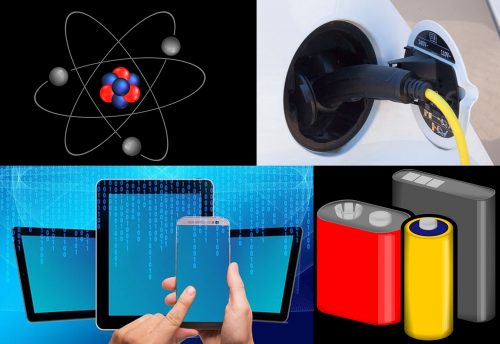Lithium recovery from wastewater and seawater has come a step closer with the development of a new metal ion extraction technique that imitates how living cells do it.
You can read a detailed description of the new technique, which uses “metal organic frameworks with subnanometer pores” to filter and transport alkali metal ions, in a research paper that was published online recently in Science Advances.
 Applying a new method of metal ion extraction to lithium recovery may help to meet the rising demand for light-weight batteries in mobile technology and electric cars. Image: pixabay composite.
Applying a new method of metal ion extraction to lithium recovery may help to meet the rising demand for light-weight batteries in mobile technology and electric cars. Image: pixabay composite.
The “next generation material” contains “sponge-like crystals” that can capture, store, and release selected metal ions – such as lithium – from seawater and wastewater.
Potentially more efficient and less costly
The researchers believe that it could spur a technological revolution in the water and mining industries.
Lithium recovery using traditional mining and recycling is not going to be enough to meet the growing global demand for lithium to use in mobile phones, tablets, electric vehicles, and other devices that need light-weight batteries.
Also, current methods of separating and purifying lithium salts and other minerals from seawater and rocks consume large amounts of chemicals, or take a long time, like those that rely on solar ponds.
The new technique, which was developed by Benny Freeman, a professor at the University of Texas at Austin and colleagues from Monash University, in Australia and the Chinese Academy of Sciences in Beijing, imitates the membranes of living cells to filter selected metal ions from water.
Lithium recovery from fracking wastewater
Freeman can see the technique being used, for example, to recover lithium in wastewater produced by hydraulic fracturing or “fracking” at the Barnett and Eagle Ford shale formations in Texas.
The shale resources in these areas, and the wastewater generated by fracking them, are a potentially rich resource for lithium recovery.
“Produced water from shale gas fields in Texas is rich in lithium,” Freeman explains.
“Advanced separation materials concepts such as ours,” he continues, “could potentially turn this waste stream into a resource recovery opportunity.”
He and his colleagues calculate that lithium recovery using their method on the 300,000 gallons of wastewater that each Barnett and Eagle Ford well generates per year could yield enough of the alkali metal to power 1.6 million smartphones or 200 electric cars.
Desalination potential
The team can also see the new technique being a more cost-effective way to desalinate saltwater. More than half the of the water that is currently desalinated around the world is the product of a technique that uses “reverse-osmosis membranes.”
Because these traditional methods indiscriminately remove all ions – as opposed to selected ones – as they pass through the membranes, they use more energy and cost more.
The design of the new metal ion extraction technique was inspired by the work that Peter Agre and Roderick MacKinnon did on “channels in cell membranes” than won them the 2003 Nobel Prize in Chemistry.
Dr. Anita Hill, chief scientist with the Commonwealth Scientific and Industrial Research Organisation in Australia, says that the potential to use the new metal ion extraction technique for “sustainable water filtration is incredibly exciting from a public good perspective.”
She also suggests that by offering a “better way of extracting lithium ions to meet global demand,” the method “could create new industries for Australia.”
